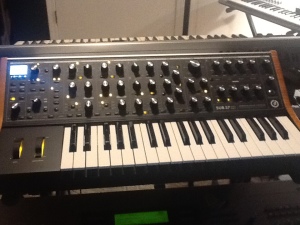Don’t get me wrong, the Moog Sub 37 is a stunning piece of analog synthesizer gear. The thing sounds wonderful and expressive, with a panel full of knobs and switches sure to delight any synth head. It’s my best musical device purchase in years — maybe ever?!
Having said all that, there are still some potential enhancements to make the Sub 37 even better. Feel free to mention any mistakes or incorrect assumptions I’ve made in the comments. After all, I’ve only had the thing for a week and a half.
Show Existing Memory Location Name when saving a Patch
When saving a patch on the Sub 37, you can either overwrite its current location or anywhere else among the 16 banks that each contains 16 locations. But the interface doesn’t display whether there’s a patch currently stored when browsing locations, making it easy to mistakenly overwrite a patch.

I’ve spent a lot of time auditioning the factory presets and making little tweaks that I want to save somewhere else. Not knowing if I am going to overwrite another patch is a constant issue.
When perusing memory locations looking for a safe home for saving a new patch, simply show the current patch name or “Init Patch” somewhere on the LCD display. The new name for the patch doesn’t need to be displayed after it is confirmed in save mode, so use that “screen real estate” for the memory location’s current contents.
Move the Oscillator Section to the Left
Since this is a hardware issue, I don’t expect anything to change, but it surprises me that the oscillator section of the Sub 37 is located in the center-right of the synth’s panel. It doesn’t seem intuitive, especially considering the original design of the Minimoog. Currently, the Glide, Arpeggiator, and Modulators (LFOs) take up that space.
At a minimum, the oscillators need to be left of the modulators. I guess I’ll have to get used to it!
Need to be able to edit Sequences
The Sub 37’s robust sequencer and arpeggiator functionality is the main reason I waited 10 months for this Moog synth instead of getting a Sub Phatty. It is really easy to create new sequences, but I can’t find any way to edit them other than starting over. The firmware needs to add a way to edit sequences.
I wish there was an Easy Way to see Loaded Patch Settings on the Panel
This is a common problem with any recent analog or VA synth that combines hardware knobs with digital patch storage. It is impossible to “see” a freshly loaded patch represented on the panel. Moog does a nice job with flashing indicators denoting LFO or arpeggiator speed, as well as the modulation destination settings.
I’d like to see something similar with the modulator sources and even the current waveform setting. Maybe potentiometers with an embedded LED to denote the original patch setting? Thanks to my ideas, the Sub 37 now retails for $6,000!
Six Knobs for the DAHDSR Envelopes
Hell, let’s increase the retail price of the Sub 37 a bit more. It’s a drag that you don’t have six discreet knobs to control the DAHDSR envelopes — you get four with a switch to bring in the Delay and Hold parameters. Two more potentiometers, Moog, just two more!
I love my Sub 37; I really do! I realize that the hardware design of the synth won’t change, but hopefully a firmware update from Moog is in the works to improve the patch saving and sequencer editing use-cases.



Pingback: The Moog Minifooger MF Delay paired with a Sub 37 | TabMuse -- a Home for Digital and Analog Music Inspiration
Pingback: Moog, Suzanne Ciani, Expert Sleepers -- Synth News Digest 2 | TabMuse -- a Home for Digital and Analog Music Inspiration
Pingback: Moog’s Subsequent 37 refines the Original Sub 37 Design – Synth News 7 | TabMuse -- a Home for Digital and Analog Music Inspiration